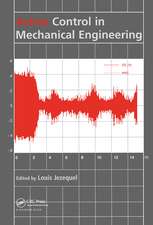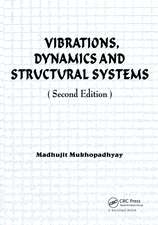Vibration Analysis and Structural Dynamics for Civil Engineers: Essentials and Group-Theoretic Formulations
Autor Alphose Zingonien Limba Engleză Paperback – 17 noi 2014
While the analysis of a civil-engineering structure typically seeks to quantify static effects (stresses and strains), there are some aspects that require considerations of vibration and dynamic behavior. Vibration Analysis and Structural Dynamics for Civil Engineers: Essentials and Group-Theoretic Formulations is relevant to instances that involve significant time-varying effects, including impact and sudden movement. It explains the basic theory to undergraduate and graduate students taking courses on vibration and dynamics, and also presents an original approach for the vibration analysis of symmetric systems, for both researchers and practicing engineers. Divided into two parts, it first covers the fundamentals of the vibration of engineering systems, and later addresses how symmetry affects vibration behavior.
Part I treats the modeling of discrete single and multi-degree-of-freedom systems, as well as mathematical formulations for continuous systems, both analytical and numerical. It also features some worked examples and tutorial problems. Part II introduces the mathematical concepts of group theory and symmetry groups, and applies these to the vibration of a diverse range of problems in structural mechanics. It reveals the computational benefits of the group-theoretic approach, and sheds new insights on complex vibration phenomena.
The book consists of 11 chapters with topics that include:
- The vibration of discrete systems or lumped parameter models
- The free and forced response of single degree-of-freedom systems
- The vibration of systems with multiple degrees of freedom
- The vibration of continuous systems (strings, rods and beams)
- The essentials of finite-element vibration modelling
- Symmetry considerations and an outline of group and representation theories
- Applications of group theory to the vibration of linear mechanical systems
- Applications of group theory to the vibration of structural grids and cable nets
- Group-theoretic finite-element and finite-difference formulations
Preț: 328.92 lei
Preț vechi: 423.91 lei
-22% Nou
Puncte Express: 493
Preț estimativ în valută:
62.96€ • 68.41$ • 52.92£
62.96€ • 68.41$ • 52.92£
Carte tipărită la comandă
Livrare economică 21 aprilie-05 mai
Preluare comenzi: 021 569.72.76
Specificații
ISBN-13: 9780415522564
ISBN-10: 0415522560
Pagini: 276
Ilustrații: 77 black & white illustrations, 13 black & white tables
Dimensiuni: 156 x 234 x 18 mm
Greutate: 0.4 kg
Ediția:1
Editura: CRC Press
Colecția CRC Press
ISBN-10: 0415522560
Pagini: 276
Ilustrații: 77 black & white illustrations, 13 black & white tables
Dimensiuni: 156 x 234 x 18 mm
Greutate: 0.4 kg
Ediția:1
Editura: CRC Press
Colecția CRC Press
Public țintă
Postgraduate, Professional, and UndergraduateCuprins
Part I. Essentials. Introduction. Single degree-of-freedom systems. Systems with more than one degree of freedom. Continuous systems. Finite-element vibration analysis. Part II. Group-theoretic formulations. Basic concepts of symmetry groups and representation theory. Rectilinear models. Plane structural grids. High-tension cable nets. Finite-difference formulation for plates. Finite-element formulations for symmetric elements.
Notă biografică
Alphose Zingoni is professor of structural engineering and mechanics in the Department of Civil Engineering at the University of Cape Town. He holds an M.Sc in structural engineering and a Ph.D in shell structures, both earned at Imperial College London. Dr. Zingoni has research interests encompassing shell structures, space structures, vibration analysis, and applications of group theory to problems in computational structural mechanics. He has written numerous scientific papers on these topics, which have been published in leading international journals and presented at various international conferences worldwide.
Recenzii
"… a valuable addition to the structural dynamics literature. In particular, the final six chapters provide a clear, concise and readable account of the group theoretical basis for simplifying the analysis of symmetric structural dynamical systems. … the book’s author presents an application of some of his own research work on group-theoretical formulations aiming to simplify the modelling of structures with symmetry."
—Computers and Structures, 2015
"… a novel approach to the vibration analysis of symmetric systems. …the book provides comprehensive guidance for students, practitioners and researchers interested in the essentials and group-theoretic formulations of vibration analysis and structural dynamics."
—ICE Proceedings-Structures-Buildings Journal, 2015
"Strengths of the book are the simplicity and clarity of explaining the basics of structural dynamics, including some worked examples and tutorial questions."
—Guido De Roeck, KU Leuven, Belgium
"This is a fabulous book, written by a true expert in the field. It is rigorous, but accessible, and it helps to simplify some of the most important but complex dynamics phenomena through an innovative link to the mathematics of group theory. This is a book I must have on my book shelf."
—Tim Ibell, President of the Institution of Structural Engineers, Bath, UK
"This book is well written and looks at an important topic in civil engineering education. It progresses from a fundamental treatment at undergraduate level to advanced topics at postgraduate coursework level and postgraduate research studies."
—Mark Bradford, UNSW Australia
—Computers and Structures, 2015
"… a novel approach to the vibration analysis of symmetric systems. …the book provides comprehensive guidance for students, practitioners and researchers interested in the essentials and group-theoretic formulations of vibration analysis and structural dynamics."
—ICE Proceedings-Structures-Buildings Journal, 2015
"Strengths of the book are the simplicity and clarity of explaining the basics of structural dynamics, including some worked examples and tutorial questions."
—Guido De Roeck, KU Leuven, Belgium
"This is a fabulous book, written by a true expert in the field. It is rigorous, but accessible, and it helps to simplify some of the most important but complex dynamics phenomena through an innovative link to the mathematics of group theory. This is a book I must have on my book shelf."
—Tim Ibell, President of the Institution of Structural Engineers, Bath, UK
"This book is well written and looks at an important topic in civil engineering education. It progresses from a fundamental treatment at undergraduate level to advanced topics at postgraduate coursework level and postgraduate research studies."
—Mark Bradford, UNSW Australia
Descriere
This book is unique among the many other books dealing with vibration and dynamics. It is divided into two parts. The first part covers all of the basics, from the modeling of discrete single and multi-degree-of-freedom systems to mathematical formulations for continuous systems, both analytical and numerical. The second part introduces the mathematical concepts of group theory, and applies these to the vibration of a diverse range of symmetric systems, demonstrating the power of this relatively new and novel computational approach.
















